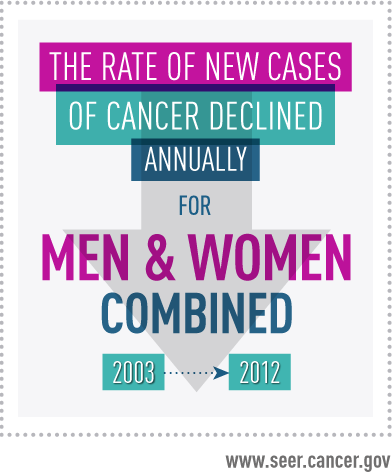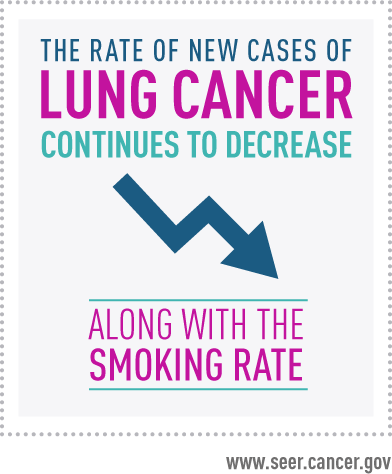Annual Report to the Nation on the Status of Cancer, 1975-2012
Cancer statistics highlight the connection between hepatitis B and C virus infection and liver cancer.
The Annual Report to the Nation on the Status of Cancer, 1975-2012, is an update on the rate of new cancer cases and deaths as well as trends in the most common cancers in the United States. The special section of this report focuses on liver cancer.
Overview
The Annual Report to the Nation on the Status of Cancer, 1975-2012, is an update of new cases, deaths, and trends for the most common cancers in the United States. Experts from the Centers for Disease Control and Prevention (CDC), the North American Association of Central Cancer Registries (NAACCR), the American Cancer Society (ACS), and the National Cancer Institute (NCI) jointly issued the report. The latest report was published March 9, 2016, in Cancer.
Key Points
- The report highlights the period from 1975 to 2012 to provide the best perspective on long-term trends in cancer incidence rates (new cases) and mortality (death) rates for all races combined.
- Researchers found continued declines in cancer mortality rates for men, women, and children.
- In contrast to the decreasing overall trends, deaths due to liver cancer increased at the highest rate of all reported cancer sites, and liver cancer incidence rates increased sharply.
- Read the full report.
Mortality Highlights

Overall cancer death rates decreased during 2003-2012 by:
- An average of 1.8 percent per year for men
- An average of 1.4 percent per year for women
- An average of 2 percent per year for people ages 0 to 19.
Trends in mortality (cancer death rates) are the gold standard for evidence of progress against cancer. Below are 10-year mortality trends for the most common cancers for men and women. These trends show that liver cancer is one of the few common cancers with increasing death rates and that its death rate is increasing the fastest among all common cancers.
Overall cancer death rates in the U.S. decreased from 2003-2012. #ARN16
Downward trends in cancer death rates provide evidence for progress against cancer. #ARN16
Incidence Highlights
Between 2003 and 2012 overall cancer incidence rates (new cases of cancer per 100,000 people in the U.S.) continued to decrease among men and remain stable among women.

The Report to the Nation has statistics on cancer incidence in the U.S. #ARN16
During this period, seven of the 17 more common cancers in men showed decreases in incidence, including colorectal, lung and bronchus, prostate, stomach, larynx, bladder, and brain cancers. Six of the 18 more common cancers in women showed decreases in incidence, including cancers of the colorectum, cervix, lung and bronchus, bladder, ovary, and stomach. Also, between 2003 and 2012, cancer incidence increased among people ages 0-19.
Overall U.S. cancer incidence rates from 2003-2012: continued decrease for men, stable for women. #ARN16
Previous Annual Reports to the Nation demonstrated that the decline in new cases of lung cancer corresponded with a decrease in tobacco use.

In the U.S., the rate of new cases of lung cancer continues to decrease. #ARN16
Special Section: Liver Cancer

In addition to reporting rates and trends for the most common cancers, this year’s report also includes a special section on liver cancer. Among both men and women, liver cancer deaths are on the rise in the United States, increasing at the highest rate of all common cancers during the period 2003-2012.
In contrast to the overall trends, U.S. deaths due to liver cancer have increased. #ARN16
A major risk factor for liver cancer is hepatitis C virus (HCV) infection. The incidence of new HCV infections was highest in the 1960s through 1980s, before the virus was discovered and preventive measures could be taken. Although risk of liver cancer for all people increases up to age 85, liver cancer incidence rates were higher among people born during 1945-1965 than among those born in other periods because of higher rates of HCV infection in the 1945-1965 birth cohort. Among persons born during 1945-1965, rates of hepatitis C infection were highest among non-Hispanic whites, non-Hispanic blacks, and Hispanics.
Cirrhosis, or scarring of the liver, is also a precursor to liver cancer. Risk factors for cirrhosis include a history of liver disease, a history of heavy alcohol use, and some rare genetic disorders. Approximately 8 to 16 percent of liver cancer deaths in the U.S. have been attributed to alcohol overuse. Increasing evidence suggests that type 2 diabetes mellitus and obesity are important contributing factors to cirrhosis and potential liver cancer.
Liver Cancer Statistics

The authors of the report found that in all racial and ethnic populations, men had nearly a threefold higher liver cancer incidence rate than women. In 2012, the most recent year for which data are available, 28,012 people were diagnosed with liver cancer in the United States (excluding Nevada). Of these, 20,207 were men and 7,805 were women. Men died from liver cancer in 2012 at more than double the rate of women, with 15,563 deaths among men and 7,409 among women.
The incidence rate of liver cancer in the U.S. is higher in men than in women. #ARN16
During 2008-2012, among both men and women, liver cancer incidence rates were highest among non-Hispanic American Indian/Alaska Natives, followed by non-Hispanic Asian/Pacific Islanders and then by Hispanics. The dominant liver cancer-related virus among Asian/Pacific Islanders is Hepatitis B virus (HBV), and infection with HBV is more common among Asians than among other racial groups, especially Asians who were born outside the United States.
The Report to the Nation has incidence rates for liver cancer by race/ethnicity. #ARN16
Prevention
CDC and other organizations recommend one-time testing for HCV for people born from 1945 to 1965. Those who test positive should be referred for appropriate care and treatment to prevent HCV-related liver disease, including liver cancer. Cure of HCV infection is associated with a 75 percent reduction in risk for liver cancer.
Other strategies for reducing the burden of liver cancer include promoting HBV vaccination; establishing and implementing public health initiatives aimed at reducing unhealthy behaviors, such as smoking and excessive alcohol use; and promoting healthy eating and physical activity to reduce obesity. CDC and others also recommend HBV testing for persons born in Asia and Africa. HBV testing and subsequent therapy is associated with a 50 to 80 percent reduction in the risk for liver cancer.
About the Report
This latest Annual Report to the Nation highlights the period 1975-2012 to provide the best perspective on long-term trends in cancer death rates among all races combined. The period 2008-2012 was used for describing the current U.S. burden of cancer, and the period from 2003-2012 was used for describing trends in cancer incidence and death rates for five major racial and ethnic groups. Finally, the period 1992-2012 was chosen to provide the best perspective on long-term incidence trends. All rates in the report are per 100,000 people in the U.S. population.
The collection of data from individual clinics or physicians can take several years, and must be carefully validated, leading to a lag time of several years between collection and dissemination via the Annual Report to the Nation.




